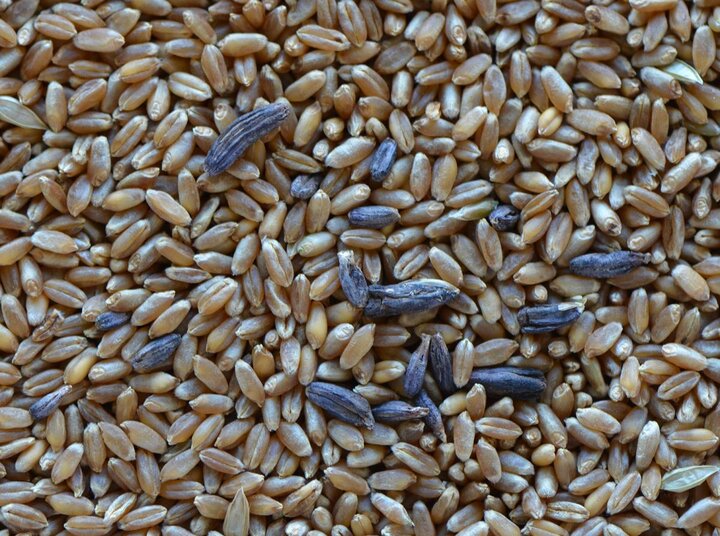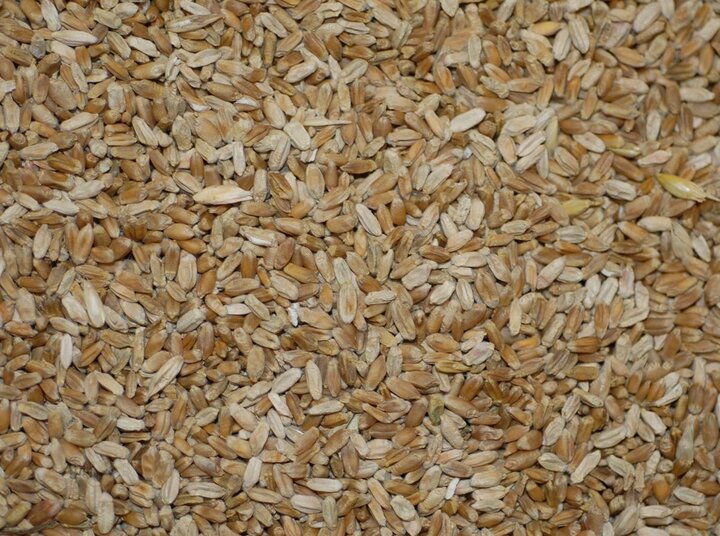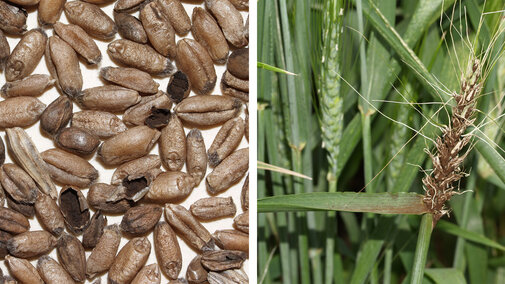Fungicide seed treatments help to reduce losses caused by seed-transmitted and soilborne fungal diseases of wheat. Some systemic seed treatment products contain a fungicide and an insecticide and offer additional protection against fall foliar diseases and insects such as aphids (which also transmit barley yellow dwarf virus) and grasshoppers.
Common bunt, also known as stinking smut (Figure 1) is one of several fungal diseases of wheat that result from contaminated or infected seed. Other diseases include loose smut (Figure 2), ergot (Figure 3), root and seedling diseases resulting from Fusarium-infected wheat seed (Figure 4) and black point (Figure 5). Black chaff (Figure 6), a bacterial disease, is also seed-transmitted.


Economic Importance of Seed-Transmitted Diseases
Seed transmitted diseases reduce yields as well as grain quality. Grain contaminated by stinking smut can be rejected at the elevator, often resulting in total loss. The pungent odor associated with contaminated grain causes livestock to reject it, significantly reducing its value as a feed. In addition, the compound responsible for the odor, trymethylamine, can cause explosions in combines and elevators when present in appropriate concentrations.
Loose smut does not affect grain quality, but can result in yield losses of up to 40%.
Incidence of ergot in wheat is relatively low. It can cause up to 10% yield loss. In 2011, ergot caused economic losses in south central and southeast Nebraska. Sclerotia or ergots (compact masses of the ergot fungus) can lower grain quality. In addition, the ergots contain toxic alkaloids that can cause ergotism and death in humans and livestock.
Seedling emergence can be reduced by up to 80% if seed heavily infected or contaminated with Fusarium is sown. For example, seed from fields affected by Fusarium head blight (scab) might be heavily contaminated with Fusarium.
Black point can significantly reduce the bread-making quality of wheat. Heavy contamination of grain with black point can result in discolored flour. This can be a cause for discounting of the grain at the elevator or rejection of the grain by millers. If such grain is used as untreated seed, reduced germination and seedling blights can occur.
Black chaff can reduce grain quality and cause up to 40% yield loss. If seed is severely infected by the black chaff bacterium, germination can be significantly reduced.
Managing Seed-Transmitted Diseases
Three strategies can be used in combination to manage seed-transmitted fungal diseases of wheat: use fungicide seed treatments and plant clean seed and resistant varieties. Seed treatments are important for several reasons.
- They control seed-transmitted fungal pathogens that may be surface-borne on the seed or internally seed-borne. Additionally, they control soil-borne pathogens such as Bipolaris, Fusarium, Pythium, and Rhizoctonia that cause seedling damping off and root and crown rots. Systemic seed treatments also provide additional protection against fall foliar fungal diseases.
- In addition to controlling diseases, fungicide-insecticide combination seed treatments also control insect pests such as wireworms, Hessian fly, and fall aphids.
- By controlling seedling damping off, seed treatments improve stand establishment and result in healthy, vigorous seedlings. Such seedlings build natural defenses that provide additional protection from diseases and insect pests.


It is preferable to buy certified treated seed or have it cleaned and commercially treated. If seed is treated on-farm, it is essential to clean it before treating it. Cleaning seed before treating is especially necessary if the seed-transmitted diseases listed above were present in the field during the growing season. For the seed treatment to be effective, ensure thorough, uniform coverage. If possible, use a broad spectrum systemic fungicide or fungicide-insecticide combination product. For a list of seed treatment fungicides for control of seed transmitted diseases of wheat, see Table I.
Fungicide seed treatments are not effective against ergot and black chaff. The best strategy for managing these diseases is using certified, pathogen-free seed.
For more information on diseases affecting grain and seed quality in wheat, see Distinguishing Between Head Disorders of Wheat (Nebraska Extension EC1872).
Resistant varieties, where available, can be used in combination with seed cleaning and seed treatments to more effectively manage seed transmitted diseases of wheat.
Managing Fall Insect Pests in Wheat
Wheat seed treated with insecticidal seed treatments can be useful in reducing infestations of aphids and grasshoppers in the emergent winter wheat crop in the fall. As the wheat plant emerges, systemic seed treatments move upward into the wheat tillers. For any insect to receive a lethal dose of insecticide, the insect first has to feed on the plant.
Considering aphids and aphid-transmitted viruses (e.g., barley yellow dwarf virus), the aphid has to feed on the plant to take up the insecticide. Even very brief feeding activity by the aphid is sufficient to transmit the virus that coats the aphid mouthparts. Therefore, while the insecticide cannot reduce the initial inoculum of the virus into the crop, the systemic insecticide will kill the aphids that feed on it, reduce the establishment of the aphid population, and thereby reduce secondary spread of the virus into the crop. By reducing the secondary spread of the virus, the virus infection is contained to only the initial plants that were infected by the virus, reducing impact on the crop.
Grasshoppers in newly emerging wheat can be problematic in some areas of the state. A systemic, seed-applied insecticide can help reduce grasshopper damage to the crop. (See Controlling Grasshoppers in Winter Wheat in the Fall for more detailed control recommendations.)
Importance of Using Clean, Certified, Fungicide-Treated Seed
The importance of using clean, certified, fungicide-treated seed cannot be overemphasized. Clean, certified, treated seed optimizes the chances of obtaining high yields. Using farmer-saved or bin-run seed is likely to result in poor variety purity, a low germination percentage, poor stand establishment, and disease, insect, and weed problems. The result will be reduced yield and poor grain quality.
Total loss may result if grain is heavily contaminated with fungal spores such as those of the common bunt fungi. Additional costs may be incurred in treating for diseases, insects, and weeds resulting from use of poor quality seed. In terms of dollars, the return from using clean, certified, treated seed will almost always exceed the cost of the seed. Using clean, certified, treated seed is a form of insurance that is definitely worth the cost.

